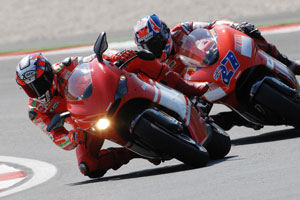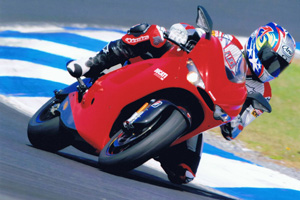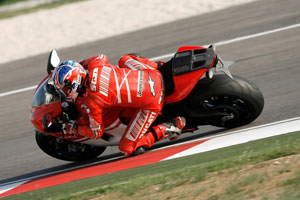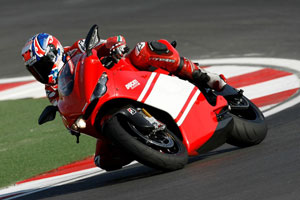Moto Online revisits the experience of Ducati’s mind blowing Desmosedici RR.

TECHNICAL FEATURES:
Engine
Like the Desmosedici GP6 MotoGP bike, the D16RR street bike features a 98mm bore and 42.56mm stroke to make up the 989cc liquid-cooled, fuel-injected, Desmodromic 16-valve, cassette type six-speed V4 engine.
The D16RR engine follows the guidelines laid down by the Ducati Corse GP engine, and the characteristic positions of the Ducati desmodromic timing system parts (camshaft rotation axis, rocker arm centre and valve centre distance), valve angle, distance between cylinder angles and pulse timing (which uses the twin pulse solution) are all the same as the GP6.
Ducati’s traditional desmodromic timing ensures accurate valve control while the engine produces a whopping claimed 188 horsepower at around 13,800rpm and 80ft-lbs of torque at around 10,500rpm (more with racing exhaust — see sidebar). Another Ducati tradition is maintained as the 90 degree angle between the cylinders is maintained.
Many racing-derived materials have been used in the engine, as the crankcase and cylinder heads are sand-cast aluminium while the cam-drive cover and alternator casing are made of sand-cast magnesium, just like the MotoGP bike.
The oil sump, cam covers and clutch cover are made by pressure die-casting magnesium alloy, again like the real GP machine.
This authentic copy of the GP engine is further endorsed by the use of a cassette type six-speed gearbox and hydraulically actuated dry multi-plate slipper clutch.
Racing technology is used in almost every piece of the engine. It features titanium con rods, intake and exhaust valves — in titanium alloy with a CrN (chromium nitride) coating — and precision grinding finishing to reduce friction on certain components such as rocker arms. Even the camshafts have been drilled and cut to reduce weight.
Lightened through finite-element simulation (FEM), the timing gears are arranged according to a pattern highly similar to the one used in the GP engine.
The piston has a double ribbed undercrown and a compact combustion chamber that brings the compression ratio to 13.5.
The crankshaft rotates on brass bearing shells and has the crank pins offset by 70 degrees to generate soft pulse timing (pulses at 0°-90°-290°-380°). This gives the bike its usable power.
The crankshaft is produced by machining a single piece of forged steel. The cone-shaped end of the crank-webs maximises the use of the available space below the piston bosses and optimises crankshaft assembly balance.
The sand-cast aluminium crankcases feature integral cylinder bores with Nicasil lining, and the crankcase halves’ separation layout is the same as on the GP engine. The oil pump is of the trochoidal (Gerotor) type and controls the water pump according to a cascade arrangement.
Also featured are four 50mm Magneti Marelli throttle bodies with 12-hole ‘microjet’ above-throttle injectors. A Magneti Marelli 5SM ECU control unit and high-speed CAN line electronics have been employed to manage the injection and electronic ignition of the four-cylinder engine. The throttle bodies, while serving two opposing cylinder heads, lie on the same plane, resulting in a straight, plunging intake port configuration.
The size of the V4 engine is quite compact. Its length is 567.4mm (1098 is 614.6mm), its height is 567.7mm (1098 is 598.3mm), but the one area it is bigger than the 1098 is width, as the D16RR measures in at 427.3mm (1098 is 409.9mm) and this is largely thanks to the extra two cylinders of the GP replica’s V4 engine.
Exhaust
The Desmosedici RR features a 4-2-1 exhaust system that comes directly out of the tail unit. The stock exhaust is compliant with Euro 3 standards and with it, the bike produces a claimed 188 horsepower with 11.2kgm of torque, but the bike also comes with a racing kit for “track use” that features a muffler and ECU to bump the power up to the magic 200 horsepower mark as well as bumping the torque up to 11.8kgm. This kit eliminates all the emission pieces, and raises the noise level up to 102 decibels to give the bike a loud and authentic MotoGP sound. It is also 4.5kg lighter than the standard unit.
Frame
Ducati has equipped the D16RR with a welded tubular steel trellis hybrid frame with the same geometry used on the Desmosedici GP6 MotoGP racing machine. The rear seat support is constructed by high temperature resin type carbon fibre that is usually used only on racing bikes, while the engine is actually used to connect the trellis frame to the rear suspension and swingarm — again, just like the MotoGP bike. Stiffness is an integral part of the D16RR frame, and it weighs 7.2 kilograms (1.8kg lighter than 1098 frame), but is much stiffer and more rigid to suit the bike’s high performance capabilities.
Swingarm
Connected by the engine to the frame, the swingarm on the Desmosedici RR is long for added stability and is made up of cast, forged and pressed aluminium alloy that features geometry and technology directly from the GP6 race bike. All this is designed to give it superb traction and it has a solid stiffness-to-weight ratio as it weighs in at just 5.4 kilograms.
Suspension
The Öhlins front suspension features 43mm upside-down FG353P pressurised forks (PFF) with TiN coated sliders. These forks come directly from competition use and, after six years of race winning performances, have finally been fitted to a production bike. Öhlins says it took a long time to get the pressurised forks to perform well on the road, but the end result gives customers a fork that handles small bumps better than any before. Designed for track use, the forks are fully adjustable in preload, rebound and compression. The compression has two adjusters and can be changed from the top or bottom of the fork, although they are not high and low speed, just for more accurate adjusting.
The Öhlins rear shock absorber is fully adjustable too and it has a very wide range of settings to choose from to get it set to a suitable setting. A cool feature of the shock is integrated temperature compensation that causes the shock to control oil flow as it heats up and gives a consistent feel hot or cold. The rear suspension geometry is the same as the GP6, with the rear shock attached above the swingarm and to a rocker, which is hinged to the engine’s crankcase.
Brakes
As the carbon brakes on the front of a MotoGP bike wouldn’t be practical for the road, Ducati has used Brembo steel brakes front and rear. Up front the D16RR uses a pair of radial monobloc callipers with four 34mm pistons, the same as those used on the 1098. Monobloc technology allows calliper stiffness to be increased and improves braking response. The front brake system is completed by a radial master cylinder, with hinged lever and trick remote adjuster. The pair of front brake discs are two semi-floating 330mm x 5mm discs, with a machined flange. Brembo also supplies the rear brake and it is made up of a 240mm disc and a calliper with two 34mm pistons.
Wheels & Tyres
For the first time ever on a production bike, the Desmosedici RR uses Marchesini forged magnesium alloy wheels with a seven spoke design that is similar to those used on the GP6. This helps to reduce unsprung weight and inertia, all the while improving handling and suspension response. The wheels feature the best compromise between weight, rigidity and resistance.
Ducati Marlboro tyre supplier Bridgestone has developed tyres especially for the D16RR project and they are named Battlax BT-01 for Desmosedici RR. The target profile of a MotoGP tyre (front: 125/60R16.5 and rear: 190/65R16.5) doesn’t meet required road standards, so Bridgestone did the math and came up with the solution of 120/70ZR17 on the front and 200/55ZR16 on the rear as a compromise.
Styling
The Alan Jenkins-designed bodywork is absolutely brilliant looking with both the Team Version colour scheme and the Rosso GP scheme. Both are stylish and well finished, looking very much like factory Ducati MotoGP racers. Each section of the fairing is carbon fibre painted in the usual great looking Ducati red, while carbon fibre is also used for the radiator duct, front sub-frame, front air duct, front fender, footpeg protections, tail, and plate carrier. The airbox is also carbon fibre.
Features
The Desmosedici-style digital instrumentation is taken from Ducati’s MotoGP GP7 project and looks similar to that featured on the 1098. This pure racing, minimalist solution by Digitek has no switches or buttons to compromise its clean lines. The wide screen allows the rider to read six values at the same time and to scroll through and select from various menus by handlebar-mounted switch gear.
Also featured is the Ducati Data Analyser (DDA), allowing riders to acquire up to 2MB of data (approximately 3.5 hours) from riding sessions. The system records several channels of data including vehicle speed, engine rpm, throttle opening, engine temperature, distance travelled, laps and lap times. So riders are able to compare, analyse and get an inside view of the Desmosedici RR performance.
The D16RR comes fitted with an Öhlins steering damper that helps keep the bike under control at high speeds, and takes a bit of the work load off of the rider at the controls.
As part of the race kit that contains the “track” exhaust and ECU to suit, the bike also comes with a paddock stand and bike cover to give it that extra MotoGP racing touch.
Maybe it was destiny. The disappointment of the world wide launch at Misano being rained out was hard to take, but Ducati Australia has remained true to its word and shipped a test bike to Australia to make up for it.
The opportunity to ride the Ducati Desmosedici RR at the world launch in Italy was a great one, but the chance to take the bike for a spin at Phillip Island on home turf is an even better one.
Sure, a nice trip to Italy to ride an Italian masterpiece sounds glamorous, but at the end of the day I’m here to test a bike and write about it. There’s no better place to get an impression of a bike in the world than the flowing twists and turns of the Island.
Not to mention the memories of Ducati’s 2007 MotoGP World Champion Casey Stoner blitzing the field in his home race back in October. It’s been a special year for Ducati and to have a D16RR launch in their world champ’s own back yard is special to the boys from Bologna too.
Unlike a lot of replica rip offs, the Ducati Desmosedici RR is the real deal race replica for the road.
Round Two
Fast forward three months from the disappointing rain cancellation at the world launch in Italy and I find myself ready for round two at the Island. This time the rain is nowhere to be seen, although you never can be sure at Phillip Island, and my long awaited test of the D16RR is looking to finally become a reality.
During the press introduction I hear Ducati’s multi time Australian Pro Twin Champion Craig McMartin giving to bike a warm up session to check things over and it instantly reminds me of Vito Guareschi on track at Misano.
Soon enough it’s my turn to do some laps. The team of mechanics pull the bike off its stand and take the tyre warmers off (both which come with the bike) before they fire it into life.
Getting the feel
Climbing onto the bike isn’t too different to the feeling I had in Valencia when I tested Stoner’s real 800cc GP7 last month. There is less pressure because there isn’t a gaggle of MotoGP riders and press around, but those same nerves about riding a very special bike creep into my head.
The seating position of the RR is neutral like the real MotoGP bike, although it sits you higher on the bike and the entire cockpit looks very much like the GP6 that Troy Bayliss and Loris Capirossi rode to a 1-2 finish at Valencia’s final 990cc MotoGP race last year.
With a pretty tall seat height, the seat position tilts toward the front of the bike and puts you in a track position pretty naturally. This is not so bad for at track days but I’m not sure what it would be like for the long haul.
The chassis feels rigid from the moment I sit on the thing. It definitely feels like a race bike and everything from the seat foam to the suspension settings feels stiff. The welded tubular steel trellis hybrid frame is stiff and light compared to the 1098 and is designed to match the bike’s high performance capabilities.
Also giving the bike that rigid feel is the double-sided swingarm, made up of cast, forged and pressed aluminium alloy.
I give the engine a handful of gas leaving the pitlane and experience the brute power of a 990cc MotoGP bike for the very first time — a GP replica anyway.
The bumps are much more noticeable almost immediately than what they were on the new Ducati 848 that I rode earlier in the day, and that rigid feel is magnified over any major change of surface.
The Alan Jenkins designed fairings and look of the bike looks just as immaculate when the speedometre is reading over 200km/h and the D16RR truly has that magic MotoGP feeling about it. It feels closer to a MotoGP bike than a usual Ducati street bike like the 1098 in many ways.
Like the 1098 and 848, the dash is derived from the GP7 and reads rpm, speed, bike and air temperature, time and it also has the usual warning lights and what not.
I find it pretty difficult to steer for my first couple of laps. The stiff chassis and racing geometry requires the bike to be ridden quite aggressively and it doesn’t respond very well to being pampered.
Grab it by the neck and it will react like a true grand prix machine, baby it and it will eat you alive. But it does take time to get comfortable enough to push it that bit extra to allow it to work the way it should.
A tight first few laps sees me skipping off of bumps and feeling a little unstable at speed as I struggle to really get a feel for it. Its high rear end puts quite a lot of weight on the front tyre and it takes a little bit to get a feel for those characteristics.
Hold on tight!
It’s not only the chassis that is vastly different to an average street bike but also the engine. At first I was trying to ride it in low gears and rev it hard off of each corner, but I soon realise that the best way to ride it is to lag the engine and let the massive amounts of power do the work by pulling off the corners.
Surprisingly, that is possibly the best thing I work out in my 15 minutes onboard the D16RR. Once I begin to use the 80ft-lbs of torque and ride a gear taller off some corners, the whole bike reacts differently.
Gone is the abrupt hit and in comes a nice smooth flow of power that will tear your arms out in true MotoGP style. Like all racing-style motorcycles, the harder you ride it then the more aggressive it will become.
The power works hard and pulls from around 9500rpm to around 14,000rpm, with its maximum power made at 13,800rpm. It is certainly capably of spinning the tyre on corner exit if that’s what you’re in to.
It is amazing what a difference it makes to the chassis behaviour when the engine is used how it’s supposed to be. My whole ride is smoothened up and the flow is much better around the track altogether.
Handle with care…
The Öhlins 43mm upside-down FG353P pressurised forks (PFF) with TiN coated sliders seem to have a pretty plush feel and transfer the weight well on corner entrance, and the fully adjustable Öhlins shock absorber does likewise on the exits.
The Brembo radial monoblock calipers clamp the twin 330mm discs up front and the stopping power into Honda corner and MG is phenomenal. The light weight of the bike at just 171 kilograms (dry, claimed) allows it to pull up in a hurry, while the slipper clutch is flawless when the rider gets it right.
The slipper doesn’t work quite as good as a real MotoGP bike with all the electronics, and still requires a bit of throttle blipping and clutch to get it really smooth.
Changing up gears is a little more difficult as the rider needs to get it correct and I miss a gear in a few sections a couple of times because I wasn’t careful enough. It selects very quickly, and this takes a little time to get used to.
I could not give a fair assessment of the Bridgestone Battlax BT-01 tyres, designed specially for the Desmosedici RR, because there was rubber all over the track from the V8 Supercar race held just days before the test.
As soon as the D16RR’s tyres get sticky they pick up loads of rubber sitting on the track, giving the tyres a spongy feel, although I’m sure without the excess rubber on them they would provide excellent grip. There would actually be more rubber on the tyre when we come into the pits than on exit. Imagine that.
How close to the real deal?
So just how close is this bike to a MotoGP contender? The chassis is very, very similar overall and gives that grand prix feeling you would expect from a race bike — stiff, light and agile.
The engine has more life than any other production bike, although I never rode a 990cc MotoGP bike to compare it to the real deal. The D16RR is loud once the track exhaust is fitted, and it has a deep bark like the 990s, and unlike the screaming 800s.
Ducati hasn’t taken any shortcuts with this bike and I believe it is as close to riding a MotoGP bike as it gets without having the talent levels of Casey Stoner and his peers. It is MotoGP to the masses and I wish I had one for the track everyday.










Newsletter